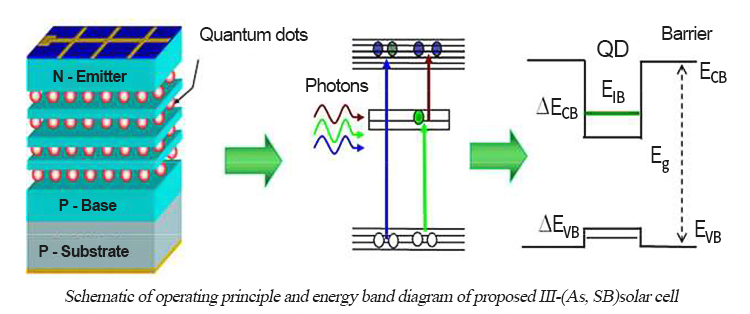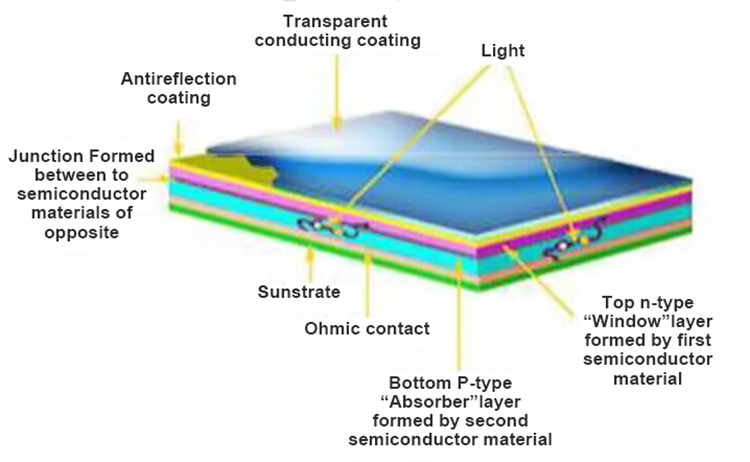Types of Solar Cells and its Applications
A solar cell is an electronic device which directly converts sunlight into electricity. Light shining on the solar cell produces both a current and a voltage to generate electric power. This process requires firstly, a material in which the absorption of light raises an electron to a higher energy state, and secondly, the movement of this higher energy electron from the solar cell into an external circuit. With regard to the development of sustainable energy, such as solar energy, in this article we will Study types of solar cells and their applications.
Quantum Dot Solar Cell
A quantum dot solar cell is a solar cell design that uses quantum dots as the absorbing photovoltaic material.
It attempts to replace bulk materials such as silicon, copper indium gallium selenide (CIGS) or CdTe. Quantum
dots have bandgaps that are tunable across a wide range of energy levels by changing the dots' size. In bulk
materials the bandgap is fixed by the choice of materials.
This property makes quantum dots attractive
for multi-junction solar cells, where, a variety of materials are used to
improve efficiency by harvesting multiple portions of the solar spectrum.

Thin Film Solar Cell (TFSC)
A thin-film solar cell (TFSC), also called
a thin-film photovoltaic cell (TFPV), is a second generation solar cell that is
made by depositing one or more thin layers, or thin film (TF) of photovoltaic
material on a substrate, such as glass, plastic or metal. Thin-film solar cells
are commercially used in several technologies, including cadmium telluride
(CdTe), copper indium gallium diselenide (CIGS), and amorphous and other thin-film
silicon (a-Si, TF-Si).

A biohybrid solar cell is a solar cell made using a combination of organic matter (photosystem I) and inorganic matter. Biohybrid solar cells have been made by a team of researchers at V anderbilt University. The team used the photosystem I (a photoactive protein complex located in the thylakoid membrane) to recreate the natural process of photosynthesis to obtain a greater efficiency in solar electric energy conversion. These biohybrid solar cells are a new type of renewable energy.

The biohybrid cell however, is still in the research phase. The team from V anderbilt University began conducting research on the photosynthesis when they began to see and focus on the photosystem I protein. After seeing how widely available and efficient the protein was at solar conversion they began to look to incorporate and improve different technologies. The team used spinach as their source for the photosystem I. Thylakoid membranes were isolated and then went into a purification process to separate the photosystem I from the thylakoid membrane. Their research resulted in a greatly improved electrical current (1000 times greater) compared to those previous made by other solar cells. The team has been gathering a group of undergraduate engineers to help build the first prototype of the biohybrid solar cell. The team has also come up with a second design of the protein complex the photosystem II. Micromorph Cells (Tandem-Cell Using a Si/μc-Si)
Micromorph solar cells are thin film solar cells based on a multijunction - architecture consisting of two solar cells that are stacked on top of each other. While the thin amorphous silicon top solar cell absorbs the blue light, the thicker microcrystalline silicon bottom cell absorbs the red and near-infrared light, allowing this so-called tandem cell to cover a wider range of the solar spectrum.

Silicon (1.7eV) and microcrystalline
Silicon (1.1eV) are well suited for tandem solar cells, the Shockley - Queisser
limit of this solar cell allows conversion efficiencies of over 30%.
In reality this limit can not be reached
and typical stable efficiencies are about 9% (world record 11.7%). That is well
over the stable efficiencies of single junction thin film silicon solar cells
which are around 6%. One reason of the low costs of silicon thin film solar
cells is its very low thickness (2 μm) compared to silicon wafer (200 μm). In
the red and infrared wavelength range 2 μm of silicon are not enough to absorb
all light and therefore Light trapping is needed.
Some of Applications of solar energy
Power plants: In
conventional power plants non-renewable energy sources are used to
boil water and form stream so that turbines can rotate and water to produce
electricity. But with application of solar renewable energy heat of sun can boil that water to create steam and rotate
turbines. To convert sunlight into electricity solar panels, photoelectric
technologies and thermoelectric technologies are used.
Residential
appliances: Homes Use of solar energy is increasing in
homes as well. Residential appliances can easily use electricity generated
through solar power. Besides this solar energy is running solar heater to
supply hot water in homes. Through photovoltaic cell installed on the roof of
the house energy is captured and stored on batteries to use throughout the day
at homes for different purposes. In this ways expenditure on energy is cutting
down by home users.
Commercial use: On roofs of different
buildings we can find glass PV modules or any other kind of solar panel. These
solar panels are used there to supply electricity to different offices or other
parts of building in a reliable manner. These solar panels collect solar energy
from sun, convert it into electricity and allow offices to use their own
electrical power for different purposes.
Ventilation system: At many
places solar
energy is used for ventilation purposes. It helps in running bath fans, floor
fans, and ceiling fans in buildings. Fans run almost every time in a building
to control moisture, and smell and in homes to take heat out of the kitchen. It
can add heavy amount on the utility bills, to cut down these bills solar energy
is used for ventilation purposes.